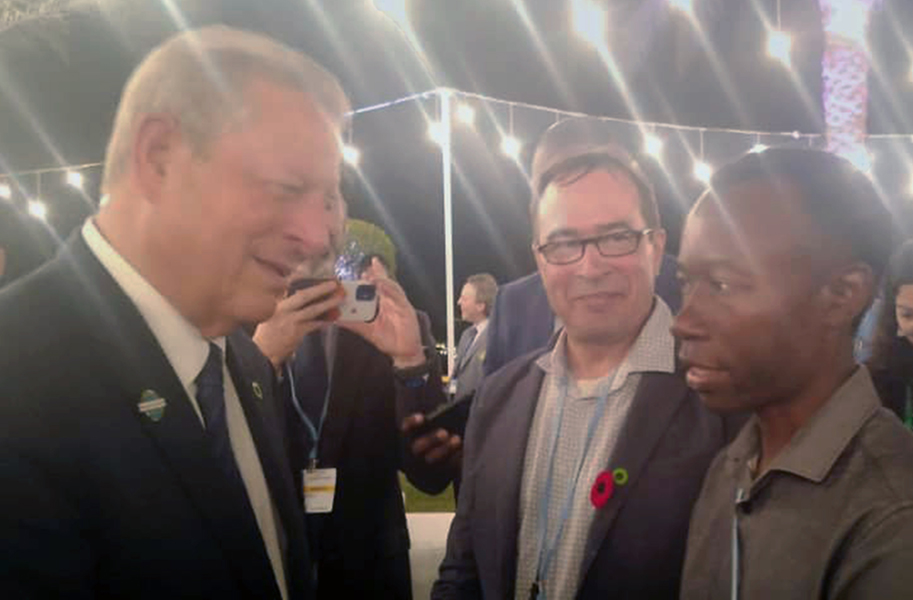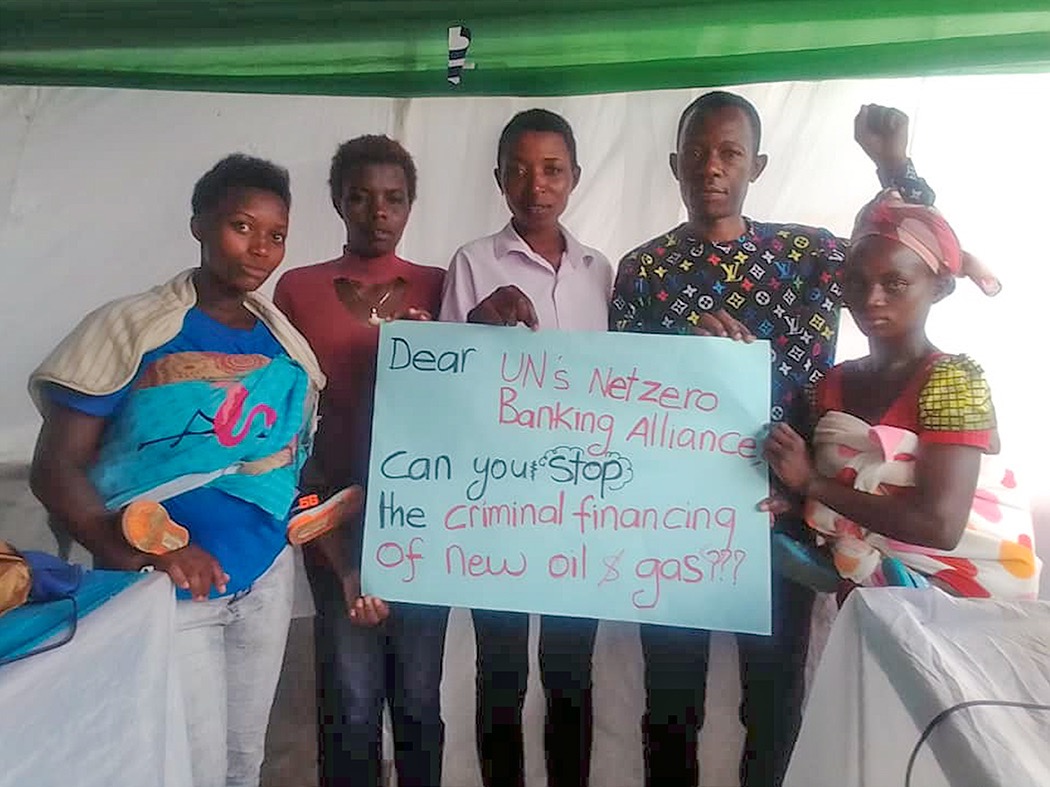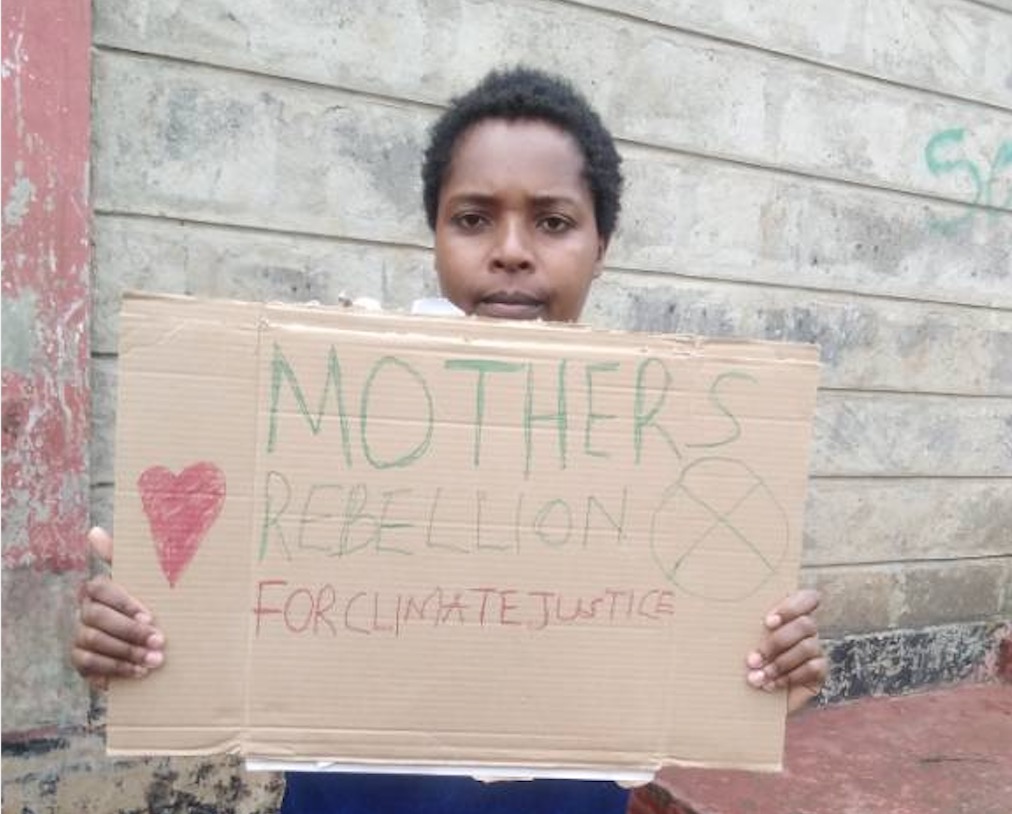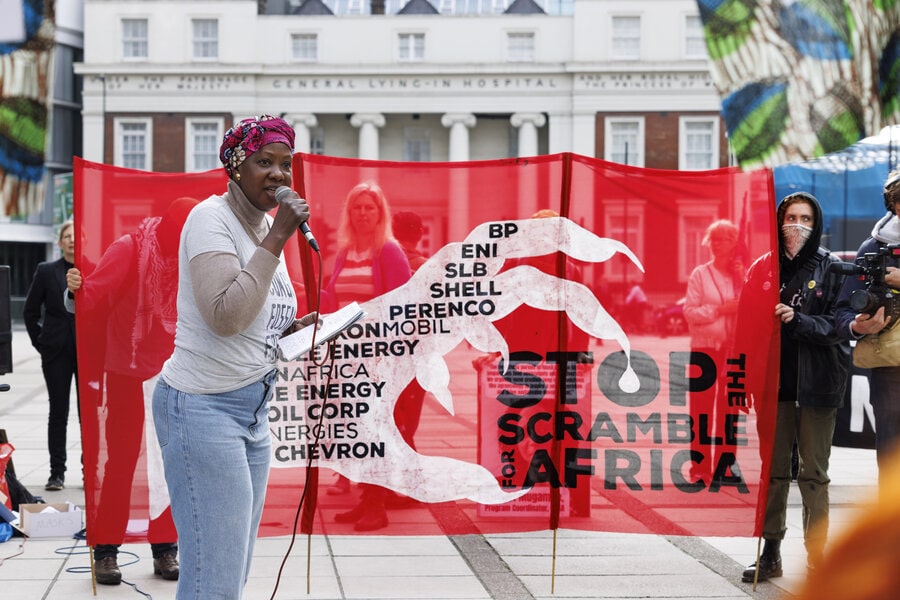My name is David Jesero. I am from Uganda but based in Rwanda.
In 2018, I joined the climate movement, organising first with Extinction Rebellion. In 2021, I also joined Climate Reality Leadership Corps, an initiative that includes training local leaders about climate change so that they can then educate others in their community. Founded by former US vice president Al Gore, I was trained by him online. The following year, 2022, I added two more movements: Scientist Rebellion, followed by Debt for Climate.

The year after attending online classes taught by former US vice president Al Gore, I met him in person November 2022 at COP27 in Egypt, at a reception he organized for all the trainees at Sultan Garden Hotel, Sinai Governorate, Red Sea. Photo by Fidele Uwihoreye, Climate Reality Leader, Rwanda.
This story, beginning in Mawundwe village in central Uganda, traces and summarises my climate journey across key moments of my life, recollecting and sharing inerasable climate realities that have greatly shaped and influenced my involvement with the climate movement. On the other side, the story shows how my inquisitive approach toward farming helped me solve the pesticide puzzle, save my harvest, and protect nature, all by using hitherto unthought-of natural formulas to treat crops. What's more, solving this challenge redefined my interaction with nature, leading me to become a caring, nurturing protector and steward. The story features my grandmother, a climate hero, a special friend, and brave woman who looked after me during my first encounters in what I only recognize today as being climate change. I will always be deeply indebted to her.
1984: Too Many Caterpillars; Not Enough Water
January, February, and March are usually busy months, as they were in 1984 when I was six years old. At 6am, the disturbing noise of farmers sharpening their hoes told every other farmer that if they were still in bed, they must be in the wrong place. Still, this didn’t prevent Grandma and me from starting our day at 7:30am. Work would normally begin after preparing our modest breakfast: boiled water infused with crushed sugarcanes, served with fire-preserved leftover sweet potatoes. I don’t remember anything that could possibly distract me from focusing my attention on Grandma as she presented this seemingly heaven-sent breakfast for us.
From April to May, farmers tended their fields and gardens, some fixing scarecrows to protect their crops from birds, others staying in their fields themselves in order to reduce the risk of thieves and pests. Then came scorching June—a terrible month that saw thousands if not millions of caterpillars crawling across crops and trees, robbing us not only of the chance to climb our own trees, but also of a good harvest. Some of these insects were such specialists of destruction that vines in many of the sweet potato fields were left leafless. I remember Grandma’s immediate reaction—achievable as our field was small—being to pick off the caterpillar-infested leaves and bury them in the soil. The next day, she took ground hot chilies and mixed a good quantity of them in water, sprinkling the solution on the sweet potato vines.
While her plan worked for us, it could not do so on large fields and farms. And so, the caterpillars continued their terrorism, assisted by the scorching temperatures. Although we were still on the safe side controlling and coping with the caterpillars, yet another challenge—water shortages—knocked on our door. Streams and natural springs dried up, and from morning 'til evening, children as young as myself would join the water chase. We walked with neighbours for miles and miles in search of hidden water pockets stashed away in forests and rocks.
July to August was harvest time. The harvest, although varied, was very thin. First, sorghum, was used both to make flour for porridge as well as acting as an ingredient in a traditional brew called “kaliga” (which means lamb). The name kaliga is used for this brew because of its fresh taste, which is likened to the innocence and beauty of a lamb. Then there were tree peas, beans, sweet potatoes, cassava, groundnuts, maize, and several other kinds of funny-looking hairy crops, some of which were traditionally eaten without salt. Everything was there, but in such small quantities you could see disappointed faces of young and old people as they harvested each crop.
Bitter Harvest
One day, after bringing our harvest home and helping Grandma do a bit of sorting, I decided to stroll over to our next-door neighbour, a fairly small family of seven, most of them aged under 20. I found them sitting under a huge bougainvillea tree, barefoot. There was so much silence. Only the hands were busy, eyes looking down at the crops that had failed to produce a miracle. Then, one of the girls broke the silence, saying, “What is a meal without beans?” In many parts of Uganda and Rwanda, beans replace meat, but now their "meat" had protested. Additionally, sweet potatoes were very small that season. Most grew long, thread-like structures inside, which made people lose their appetite. Those who forced themselves to eat it got indigestion and gagged; it was not really sweet potato anymore. Banana trees bore so few bananas—a mere five or ten, tiny and very thin fruits—not the hundred or more per plant in a normal harvest.
As usual, I helped my disappointed hosts a little, then returned to meet my grandma. We had little, too, but it was only the two of us. Cassava was available, but had turned bitter and poisonous, even deadly. Although people died eating it, others continued to do so anyway. Food prices went up everywhere, and families whose harvests had failed badly worked on rich people’s farms. Called “food slaves,” they would be given a certain quantity of food instead of money. It was a common practice. The season was brutal, but somehow, people coped by eating things that would be impossible to eat in good times; hence the saying, ndiirabutafa, meaning, “I eat just for the sake of not dying.”
However, it was not always like this. There were small, good times sometimes, such as when families produced a big harvest, and even got a surplus. That is when neighbours would send a small sampling of their harvest to others, especially to those who might have planted late. Grandma did this for a young man who had recently settled near us. He didn’t have a field ready with crop, just a natural grass-thatched hut and a good dog. Warming for marriage at 23, he was busy working like a donkey on many different farms to raise the dowry: many sacks of dried beans. In normal circumstances, the dowry a virginal young woman claimed would be a good number of cows, but in times of crisis, this adjustment to sacks of beans was still honourable.
Time marched on, and soon it was September, then October: another season of planting to keep the chain of life going. November began with good rains, and all the farmers were relieved. Grandma had a variety of traditional indigenous crops that I rarely see these days. Among them were several kinds of richly coloured beans, swamp and upland yams, and leafy vegetables. The intervals of rain and sun continued normally for some time, until the notorious hailstones and mataba, or floods, came.
Too Many Ways to Die
At one point a woman, who was conversing with Grandma during a burial where two girls from the same family had been struck by lightning, described how, before it started to rain, she had seen a figure in the sky that I can only try to understand today as some kind of climate dragon. Such a sight was not the first rainy season that had come with ghosts, turning peaceful neighbourhoods into slaughterhouses. Among the indigenous Karamajongs, people and livestock died in the hundreds for days and days, rotating the death toll between hunger, disease, floods, and lightning.
At the burial, as people continued to talk about the horror, I only remember looking intently into their eyes, switching from one person to another, and in the process, absorbing ever more climate stress. Unfortunately, as these things have continued to happen over and over again throughout my life, climate change and its losses have become like a normal, albeit agitating, illness.
Grasshoppers Bring Hope; Heat Does Not
November and December, although unpredictable, have a way of leading people to relinquish bad memories. This is especially because in Uganda, these two months are associated with grasshoppers, a traditional delicacy. After the tragedies caused by lightning and floods, the long-awaited grasshoppers come, arriving in huge swarms across almost the entire central and western regions of Uganda, their beautiful humming filling everyone who hears them with so much hope. After nature had turned against the people, it was at last giving something back: a sign of its unbreakable contract with them. Hungry families and children woke up early in ‘Grasshopper November,’ heading for grasshopper hotspots: grasslands, maize fields, and banana plantations. Some families and individuals also set out a lamp at night, surrounded by improvised grasshopper-harvesting equipment. In the morning, both grasshoppers and happiness were bountiful. Finally, for days on end, people would have a free takeaway courtesy of nature’s unconditional benevolence.
But the following year, 1985, it was the opposite. November and December became mean with their grasshoppers, causing many to ask: what is going on? Hot seasons became exceedingly violent, wrecking farms and fields. Bony-looking bodies were everywhere. You could hardly hear a single giggle from kids. It was much like Rachel Carson’s Silent Spring. Some of the local natural streams and springs where people used to collect water had dried up and were now replaced by ghostly cracks that seemed as though they would widen and swallow up all sorts of things. Chaos and desperation were everywhere. In the same season, local health centres were filled with sick, hungry people. But thanks to the presence of natural gardens and private ones maintained by traditional conservationists, tropical herbs from both helped—and still—save many lives.
Significant Signs
With access to electricity, television, and the internet, more people have begun to realise that what is happening in their communities is also happening in other parts of the world, all of which is caused by a reckless indifference to climate accountability.
 "These women—Eliane, Cecile, Ange on the left and Clemantine on the right—participated in the climate actions I organised under XR Green World Youth Rwanda. Photo by Placide, Spring 2022."
"These women—Eliane, Cecile, Ange on the left and Clemantine on the right—participated in the climate actions I organised under XR Green World Youth Rwanda. Photo by Placide, Spring 2022."
These women—Eliane, Cecile, Ange on the left and Clemantine on the right—participated in the climate actions I organised under XR Green World Youth Rwanda. Photo by Placide, Spring 2022.
![In the second photo, lower left, taken during a May 2023 action on secure food systems and ecosystems, Jesero sits next to a young woman selling her vegetables in an outdoor farmer's market as he holds a sign reading: Ban DDT. In the third photo, lower right [2022], the sign Jesero holds reads: Stop harassing and grabbing indigenous people's lands. They look after 80% of the world's biodiversity.)](/assets/uploads/davidjeseropairedphotos5.21.23_photoshopevensmaller.png) "These two photos (and the one above)—all taken in Muhanga town—propel and echo earth defenders' concern about secure food systems and secure ecosystems. "
"These two photos (and the one above)—all taken in Muhanga town—propel and echo earth defenders' concern about secure food systems and secure ecosystems. "
These two photos (and the one above)—all taken in Muhanga town—propel and echo earth defenders' concern about secure food systems and secure ecosystems.
Nature Treats Nature
From 2016 through 2018, I was a teacher and a farmer at the same time. Unlike other modern farmers, I didn't have the money to buy a spray pump, nor the chemicals to control pests on my maize field. Most of the pesticides used in Uganda and Rwanda are made in China and India. They are affordable, but not by everyone. As pests began raining on my field and all around me, other farmers were already prepared, busy spraying their fields of maize, tomato, and cabbage. I was the odd one out, restless for a solution. It was my energy, my time, and finally, my crop at stake. Cornered into coming up with a solution, I observed that the pests start laying eggs inside the bud of each maize plant, eat the buds, then move out to the other leaves, redesigning each with multiple holes.
I asked myself, “Since the pest does not come from the soil, could soil be an enemy to the pest?” As I investigated deeper, I discovered a rodent’s burrow. I noticed fine soil at the front, which the animal had pushed out in a bid to create enough space for itself and its family. I took small but sufficient amounts of this soil, spreading it into the bud of each plant, repeating this exercise day after day. Quite happily, this observation-led experiment worked, not only spelling the end of the maize pests, but providing a miraculous harvest I had never dreamt of. Many of the maize plants had three long maize cobs on them, well filled with healthy-looking cereals. I entered the next season with a surplus from the previous one. In 2022 and 2023, I repeated this routine in Rwanda, and the results were equally amazing, superior even to those who used toxic pesticides.
I have now named this approach ‘Nature Treats Nature,’ and I shared it at COP27. This experience confirms the story shared by a Jewish rabbi, Yonatan Neril, during an interfaith session at COP27, that “the solutions to the climate problem are within our hands.”
They are indeed.





